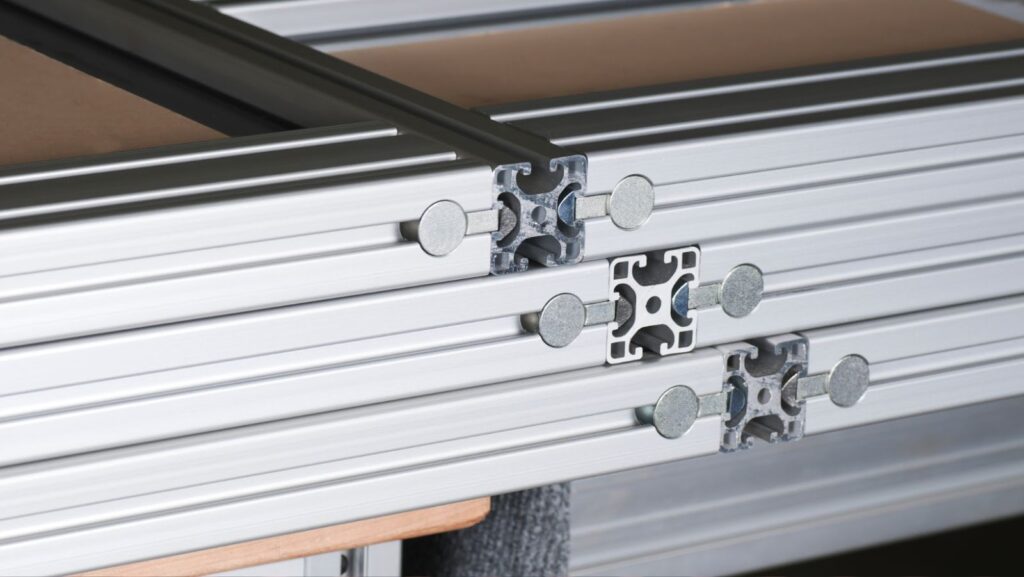
The use of materials to create manufactured products involves a technological process of forming the selected material into the required shape. The extrusion process (from the Latin extrusio – “pushing out”) is one of the most versatile. It is used in a variety of industries, from the food industry to the production of metal structures.
The only requirement for the material is its plasticity. To shape the material, it is pressed through a hole of a given geometry, resulting in an elongated piece with the required profile. Therefore, this process can be used to process polymers, plastics, building materials, metals, and more.
The vast majority of industrial metals and alloys are solid at room temperature. Therefore, the extrusion process takes place at elevated temperatures, at which the metal acquires the necessary plasticity. In this article, we will look at the aluminum extrusion process and its impact on the aircraft industry.
The widespread use of aluminum as a structural material for aircraft and aerospace machines is due to a set of unique properties that make it indispensable in this industry. First of all, it is its low density, which is 2.70 g/cm3 at room temperature. Compare this to iron’s density of 7.874 g/cm3. This means that, for example, an airplane body made of aluminum will be almost three times lighter than an iron one! Thus, it will take three times less fuel to get such an airplane into the air and accelerate it. Ultimately, this makes the production of such aircraft much easier and exploitation cheaper. In addition, aluminum’s corrosion resistance, high thermal and electrical conductivity, strength, ductility, and wide range of processing options combine to make it widely used in the aircraft and aerospace industry.
The aircraft/aerospace aluminum extrusion process takes place at temperatures of 425-495°C (800-925°F). Typically, an aluminum billet heated to this temperature is treated with machine oil to prevent sticking and moved into the extruder chamber. There the billet is pressurized to fill the entire chamber space. The aircraft/aerospace aluminum extrusion process can be carried out in a stream of gaseous or even liquid nitrogen, which is used as a coolant in certain areas and also creates an inert atmosphere to prevent oxidation of the sample and chamber walls, which increases the service life of the equipment.

For the production of aircraft aluminum or aerospace aluminum extrusions, the specimen is forced-cooled by a series of fans along the entire length of the output mold. Once the sample is of the desired length, it is sent for additional processing. This usually involves stretching, which flattens and increases the hardness and strength of aircraft or aerospace aluminum extrusions. The next step is cutting to a specific length, followed by artificial aging, i.e., heat treatment in furnaces that hardens the metal by accelerating the aging process in a temperature-controlled environment for a set period of time.
What Are the Pros/Cons of this Process for Aircraft and Aerospace Vehicles?
It is clear that in the aircraft and aerospace industries, special attention is paid to the safety of aircraft. In today’s world, according to statistics, flying by air is a much safer way of transportation than traveling by car. Of course, this is a direct result of efforts to ensure safety. After all, the responsibility for the flight is shared between the airline and the aircraft manufacturer, while the safety of a car driver largely depends on the driver himself. The safety of aircraft is based on the quality of construction materials and structural reliability. In addition, reliability naturally reduces the cost of operating, repairing, and replacing equipment. Therefore, high product quality standards in this area require manufacturers to strictly comply with regulatory requirements that guarantee the reliability of equipment. In turn, this saves resources and ultimately saves lives.
Modern extrusion processes for the aviation and aerospace industries are now highly automated, and the relevant regulations are prescribed in detail depending on the aluminum alloy used and the desired shape of the extrusions. This leaves a limited margin for error and significantly reduces the reject rate and, thus, the cost of production, as well as the reliability of the resulting products. Nevertheless, even in an ideal extrusion process, fragments of the workpiece are produced that cannot be used. For example, the residue (butt) contains metal oxides from the workpiece, so the end is cut off and disposed of. However, careful adherence to the protocols is not a one hundred percent guarantee of reliable extrusion molds. That’s why the quality of the parts of the blank is carefully checked using certain inspection methods, among which tensile testing is the most informative mechanical test.
Tensile testing of aluminum extrusion samples is one of the most important mechanical quality control methods for the needs of the aircraft and aerospace industries. The measurement is based on applying a tensile force along a specimen of a certain shape and recording the change in the specimen’s geometry depending on the effect of this stress. This determines the strength of the sample and its ability to elongate under tension.
Prior to the start of the operation, samples are taken from batches of any product produced by aircraft aluminum extrusion and subjected to quality control, including tensile testing. Special machines are used for this purpose. The material is subjected to a uniform force that stretches it until it breaks, and the change in the geometry of the sample under the influence of mechanical stress is measured. This determines the material’s ability to withstand certain stresses and, thus, its reliability. Given the high-quality standards of the products used in the aircraft and aerospace industries, the processes for controlling the mechanical properties of aluminum parts samples are also well-automated and standardized. The applied load is programmatically controlled, and the material response is measured using special sensors. The results are also recorded and processed using the software. This approach ensures the reliability and accuracy of the test results.

However, to obtain reliable tensile test results for aluminum specimens in the aircraft and aerospace industries, it is also necessary to ensure that the shapes of the specimens are accurately reproduced. The shape of the specimen has a critical impact on the results of mechanical tensile testing. This is understandable because where it is thinner, it tears. Therefore, the shapes of such specimens are clearly standardized. There are standards for specimens made of different materials in different sizes. However, there are only two common shapes of such specimens, the so-called dog bone tensile test specimens, which are flat or round. Their length and cross-sectional area vary according to the needs but only within the existing standards. The wider ends are used for fixing in the grips of a tensile sample testing machine, stretching occurs along the axis of the specimen, and the main changes in geometry are observed in its thin part, where it eventually fails.
Aluminum Extrusion Process Summary
Therefore, the accuracy and reliability of the manufacturing process of such specimens become one of the key factors in obtaining reliable and reproducible mechanical test results and, thus, aluminum structures for the aircraft and aerospace industries. For testing aluminum extrusions, flat tensile specimens in the form of a dog bone are typically prepared.
For managers and engineers working with aluminum extrusions, we recommend that you consider the Flat Tensile Sample Preparation system to prepare the tensile dog bones for Tensile Testing processes from TensileMill CNC Inc. This system is designed to meet the high demands of the aircraft and aerospace industries. It is simple and easy to operate. This is achieved through the use of software-controlled milling machines that are able to take on the vast majority of labor-intensive tasks and produce parts of standard sizes with high accuracy. Many years of experience with TensileMill guarantees reliable operation and timely service of the supplied equipment. That is why these machines are chosen by thousands of industrial manufacturers, educational institutions, civilian and military institutions, as well as manufacturers in the aircraft and aerospace industries.










